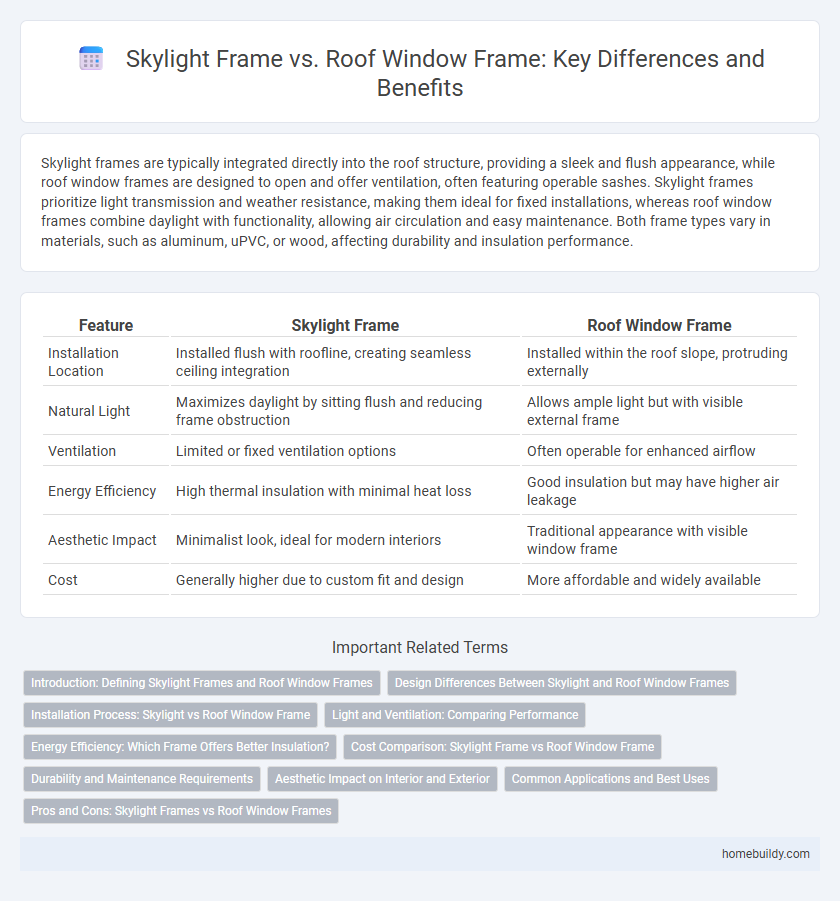Skylight frames are typically integrated directly into the roof structure, providing a sleek and flush appearance, while roof window frames are designed to open and offer ventilation, often featuring operable sashes. Skylight frames prioritize light transmission and weather resistance, making them ideal for fixed installations, whereas roof window frames combine daylight with functionality, allowing air circulation and easy maintenance. Both frame types vary in materials, such as aluminum, uPVC, or wood, affecting durability and insulation performance.
Table of Comparison
| Feature | Skylight Frame | Roof Window Frame |
|---|---|---|
| Installation Location | Installed flush with roofline, creating seamless ceiling integration | Installed within the roof slope, protruding externally |
| Natural Light | Maximizes daylight by sitting flush and reducing frame obstruction | Allows ample light but with visible external frame |
| Ventilation | Limited or fixed ventilation options | Often operable for enhanced airflow |
| Energy Efficiency | High thermal insulation with minimal heat loss | Good insulation but may have higher air leakage |
| Aesthetic Impact | Minimalist look, ideal for modern interiors | Traditional appearance with visible window frame |
| Cost | Generally higher due to custom fit and design | More affordable and widely available |
Introduction: Defining Skylight Frames and Roof Window Frames
Skylight frames are designed specifically for horizontal or nearly horizontal glazing installations, allowing natural light to enter from above without opening onto a roof. Roof window frames are built to integrate with sloped roofs, providing both natural ventilation and daylight through operable windows. The distinction lies in their installation angles and functionalities, with skylight frames prioritizing fixed light diffusion and roof window frames offering access and airflow.
Design Differences Between Skylight and Roof Window Frames
Skylight frames are typically designed to sit flush with the roofline, offering a sleek, minimalist appearance that maximizes natural light entry without disrupting the roof's aesthetics. Roof window frames often incorporate protruding elements such as sashes or hinges, allowing for ventilation and easier manual operation. The structural design variation between skylight and roof window frames affects installation complexity, thermal performance, and the overall visual integration with the building's architecture.
Installation Process: Skylight vs Roof Window Frame
Skylight frames typically require installation directly onto the flat surface of the roof deck, often involving precise sealing to prevent water infiltration and ensure proper insulation. Roof window frames are designed to fit within the roof's slope, allowing for simpler integration with existing roof structures and easier alignment with surrounding roofing materials. Installing a skylight often demands more extensive flashing and waterproofing compared to roof window frames, which benefit from manufacturer-designed installation kits tailored for angled roofing surfaces.
Light and Ventilation: Comparing Performance
Skylight frames typically provide enhanced natural light penetration due to their strategic placement on flat or low-slope roofs, maximizing daylight exposure throughout the day. Roof window frames, installed on pitched roofs, often allow superior ventilation as they can be opened fully to capture cross-breezes more effectively. The material and design of skylight frames also influence thermal performance and airflow control, impacting overall energy efficiency and indoor air quality.
Energy Efficiency: Which Frame Offers Better Insulation?
Skylight frames typically provide superior energy efficiency compared to traditional roof window frames due to their advanced insulation materials such as uPVC or thermally broken aluminum, which significantly reduce heat transfer. These frames often incorporate double or triple glazing options that enhance thermal performance, minimizing heat loss during winter and heat gain in summer. Roof window frames, while functional, generally offer less insulation efficiency because they are designed for ventilation and may use less effective thermal barriers.
Cost Comparison: Skylight Frame vs Roof Window Frame
Skylight frames generally offer a more cost-effective solution compared to roof window frames due to simpler design and installation requirements, often reducing initial expenses by 20-40%. Roof window frames tend to be pricier because of their larger size, enhanced functionality, and compliance with building regulations that may require reinforced materials. Budget considerations should also include long-term maintenance costs, where skylight frames typically incur lower expenses due to fewer moving parts and simpler sealing systems.
Durability and Maintenance Requirements
Skylight frames are typically constructed from materials like aluminum, uPVC, or wood, offering excellent durability and resistance to weather elements. Roof window frames, often made from treated timber or metal, may require more regular maintenance to prevent decay or corrosion, especially in harsh climates. Proper sealing and periodic inspections are crucial for both frames to ensure long-term performance and prevent leaks.
Aesthetic Impact on Interior and Exterior
Skylight frames create a sleek, minimalist aesthetic that enhances natural light flow and offers unobstructed views, boosting the interior's brightness and spaciousness compared to traditional roof window frames. Roof window frames often feature more pronounced borders and hardware, which can interrupt the continuity of ceiling designs and exterior roof lines. The slim profiles of skylight frames blend seamlessly with modern architectural styles, elevating both interior ambiance and exterior curb appeal.
Common Applications and Best Uses
Skylight frames are commonly installed in flat or low-pitched roofs to provide natural light and ventilation in residential and commercial spaces, enhancing interior ambiance and energy efficiency. Roof window frames are best suited for steep-pitched roofs, offering easy access for cleaning and emergency egress while maximizing daylight and airflow in attics or loft conversions. Choosing between skylight and roof window frames depends on roof angle, building design, and specific lighting or ventilation needs.
Pros and Cons: Skylight Frames vs Roof Window Frames
Skylight frames offer a flush, streamlined design that maximizes natural light and provides excellent insulation, making them ideal for energy-efficient homes. In contrast, roof window frames typically open outward, allowing for better ventilation but may require more maintenance due to their mechanical parts. While skylight frames often have a lower profile and blend seamlessly with roofing materials, roof window frames offer easier egress options and enhanced airflow control.
Skylight frame vs roof window frame Infographic

 homebuildy.com
homebuildy.com